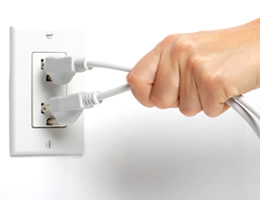Don’t Unplug It, Protect It! (Importance of Surge Protectors)
What are Electrical Surges? Importance of Surge Protectors
 When a power surge runs through your electrical lines, it can cause serious damage to the electronics and appliances in your home. In addition, it could also compromise the safety of your family. A power surge occurs when a strong electrical current travels through your power, cable or telephone lines. To protect your home against such surges, you should consider getting home surge protectors.
When a power surge runs through your electrical lines, it can cause serious damage to the electronics and appliances in your home. In addition, it could also compromise the safety of your family. A power surge occurs when a strong electrical current travels through your power, cable or telephone lines. To protect your home against such surges, you should consider getting home surge protectors.
What Causes Electrical Surges?
Electrical surges have several different causes, most of which are usually unpreventable. The best way to shield your home and valuables is to get the best protection against these surges. There are two types of electrical surges:
- External Electrical Surges
- Internal Electrical Surges
External Electrical Surges – External power surges are usually caused by the weather. They can cause damage to home appliances, electronic devices and systems in your home. Lightening is the most common cause of power surges in the home.
When lightening strikes a transformer or near your home, it can send a strong electrical current through your home and cause severe damage. Along with damage to your electrical systems and electronics, these surges can sometimes start fires.
Internal Electrical Surges – Although these power surges are caused by internal issues with your electrical system, they are similar to external surges in that they usually cannot be detected and they can cause significant damage to your home and property. The two most common causes of internal power surges are:
Utility Disturbances – Many times utility disturbances are caused by overloading the electrical system by plugging too many devices into electrical outlets. Overloading outlets can lead to power surges, power outages and electrical fires. Power strips can provide space to plug in several electronic devices, but most power strips or power bars have only minimal, if any, surge protection.
Blackouts – After blackouts have occurred and the power company restores your electricity, a surge of power can run through your electrical lines and damage your electrical equipment. This surge is unpredictable, but the damage can be prevented.
Why Power Surges Cause Damage
When high voltage electrical currents pass through your electrical lines, they can pass through your appliances and electric devices. The high amounts of voltage can easily burn out the electronic boards in these devices and make them useless. Sometimes the currents will slowly build up in electronic devices and the accumulative damage can cause the device to stop working.
These high voltage currents can also generate heat, which can damage electrical components or electrical wiring. The heat generated from these damaging currents can sometimes cause dangerous electrical fires as well.
Appliances can be damaged as well, even if they were not directly connected to the cause of the power surge. During a surge, the electrical wiring in your home can be damaged and the power surge can be passed through your home’s electrical system to other appliances and electronic devices.
How Surge Protectors can Save Money
There are several different types of surge protectors available for home use. While many people opt for using surge protection strips, they often offer little protection for your appliances or electronic devices. There are more comprehensive surge protectors available that can protect your home and property.
When you use good quality surge protectors, you are avoiding potential damage to your appliances and electronic devices, along with the information contained on these devices. A power surge will not only fry your computer, but all the information stored in your hard drive can be lost as well. This information, along with the computer and your other devices, can be costly to replace, if it is possible to replace it.
How do Surge Protectors Work?
A good quality surge protector acts to stop a power surge from making its way to the devices plugged into it. When a power surge occurs, the surge protector absorbs the extra power and shut itself down so that the surge cannot continue to travel through power cords to damage your property. When that occurs, your appliances and devices will shut down before damage can occur.
Types of Surge Protectors.
When you consider surge powers for your home, you may picture power strips or other types of secondary surge protectors. Secondary surge protectors are plugged into electrical outlets and appliances, electronic devices and other equipment are plugged into the outlets on the surge protector.
Uninterrupted power surge protectors are also available for your home. These surge protectors are secondary surge protectors that have a built in battery back up system. The battery back up allows your devices to keep operating, even after the surge protector has stopped the rogue electrical surge in its tracks.
Primary surge protectors are directly connected to a building’s electrical system to help stop electrical surges. Using surge protectors will help prevent serious damage to your home and property, as well as keep your family safe.


